
views
Using Proper Etiquette

Wash your hands before and after the meal. Since Ethiopian cuisine is a hands-on affair, clean hands are a must. Many Ethiopian hosts will bring you a pan and a pitcher of warm water. You put your hands in the pan and wait for the host to pour water over them. If you’re at home or in a public venue such as a restaurant, washing your hands with soap and water at a sink may also be acceptable.
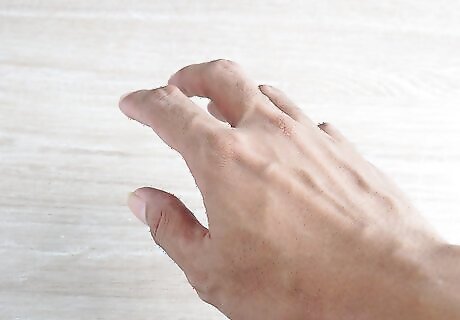
Use your right hand to handle food. Left hands are considered unclean in Ethiopia, so never use yours while eating. Keep your left hand off of the table. You can use your right hand for everything else. Eating Ethiopian food is rather simple, since all you need is a piece of injera, which is a type of bread, or a utensil. You won’t find much of a need to use both hands. This is one of the most important rules to remember. Eating with your left hand is very rude, so don’t even consider doing it. Eating directly with your right hand is also acceptable, although using injera is cleaner and easier. Remember that everyone in Ethiopia eats this way. You may find it a little difficult at first, but you will get the hang of it if you don’t give up.
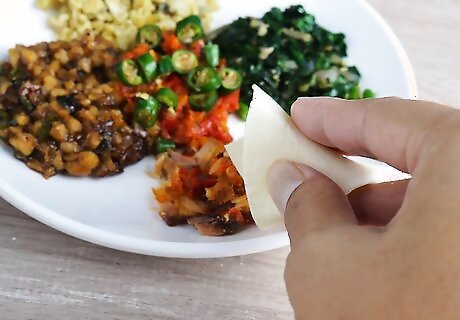
Eat the food closest to you to avoid reaching across the table. Typically, all Ethiopian food is placed on a single communal tray. You may wish to try the doro wat on the other side of the table, but reaching for it is considered rude. To access it, wait until everyone else takes their hands out of the tray. Then, spin the tray towards you so you can easily reach what you need. If you make a mistake, apologize right away.
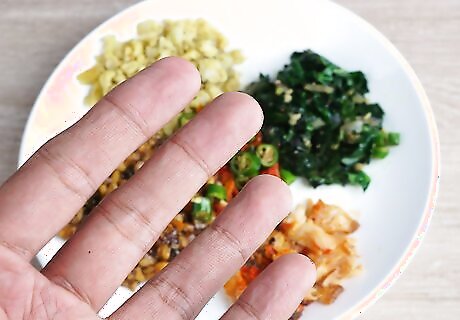
Avoid licking your fingers while eating. Licking your fingers is both gross and dangerous. Remind yourself that you often are dealing with communal plates when it comes to Ethiopian food. Putting your hands in your mouth introduces germs into the food that can get everyone else sick. You will get food on your fingers at times, but resist the urge to clean yourself. You could try discreetly wiping your fingers on the strip of injera you tear off.
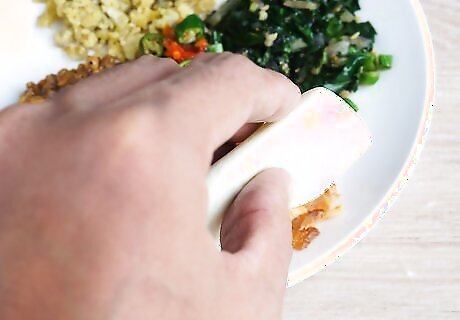
Take turns reaching into communal trays. Follow the rhythm set by other diners so you aren’t bumping hands throughout the meal. Limit the tray to no more than 2 hands at a time. If you see 2 people reaching for the tray, stop and wait for them to finish. After beginning the meal, you will quickly begin noticing when people reach for the food. As long as everyone takes turns, accessing the communal tray won’t be an issue.
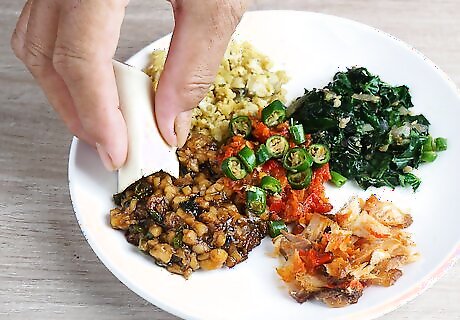
Let the eldest members at the table eat first. As a show of respect, honor the eldest members of your dining party by allowing them to reach for the food first. After they have taken their turn, everyone else can begin eating. Everyone then continues taking turns until the meal is finished. If you are the oldest member of the party, you may be expected to go first. If any Ethiopians at the table are doing nothing but staring at you, that may be why!
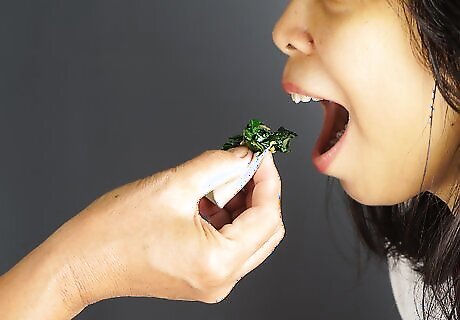
Feed others food as a sign of respect. The way you feed someone else is similar to how you feed yourself. Tear off a strip of injera with your right hand, then wrap it around some meat or curry. Gently place it in the other person’s mouth, trying not to touch their face. The larger the food, the stronger the bond is between 2 people. This tradition is called “gursha.” Friends, family members, and partners all practice the gesture to show their affection. Ethiopians usually perform this ritual twice a meal. If someone offers you a gursha, accept it. Otherwise, you will seem like you’re denying the bond you have with the other person.
Eating with Injera Bread
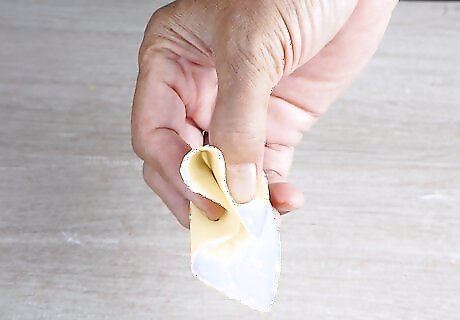
Tear off a strip of the injera. Injera is a type of bread commonly served in large quantities during Ethiopian meals. Grasp the end of the bread with your right hand, then rip off a chunk that is about as large as your palm. Keep in mind that the injera is meant to serve as a utensil. Get a piece big enough to scoop up food but small enough to fit comfortably in your mouth. If injera is served rolled, unroll it a little first so you can tear off a piece. Touch the food with only your right hand. Injera is very soft, so it isn’t too difficult to tear. You may struggle a little at first, but you’ll get the hang of it soon enough.
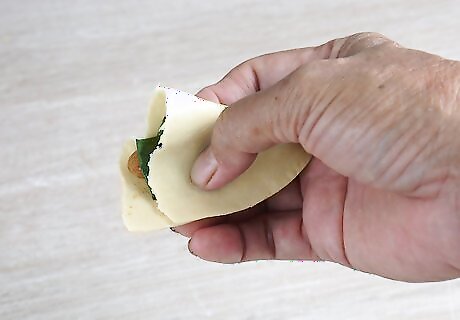
Scoop up meat, sauce, or vegetables with the injera. Lay the injera over the food on the plate. Take care to keep your fingers out of the food. Then, use your fingers to pinch the ends of the injera together, picking up some of the food. Ethiopian food is often served on a communal plate, so that is why you need to be careful about where you place your fingers. When you use injera correctly, you will keep your hands clean for the most part. Getting food on your hands is normal even for experienced diners.
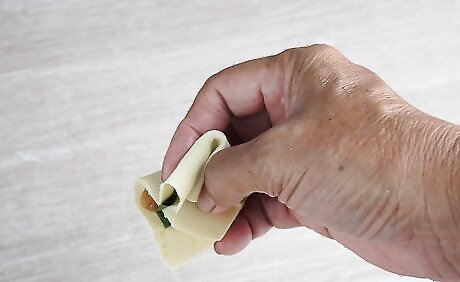
Squeeze the injera together as you move it to your mouth. Squeezing the injera holds the food in place so it doesn’t spill all over you. Set the injera carefully in your mouth. When this is done correctly, both your hands and your shirt stay clean. Avoid putting your fingers in your mouth. Since Ethiopian food is often eaten from a communal plate, touching your mouth is a no-no.
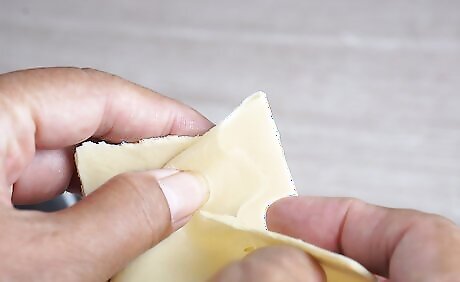
Tear and eat the injera exposed underneath the food. Ethiopian food is often served on top of a piece of injera spread over a plate. Eating this part is acceptable and expected. In fact, if rolled injera isn’t served separately, you will need to use this piece to scoop up the food. Avoid reaching underneath the food, but when you see exposed pieces of bread, you can take them and eat them with or without food. For some people, the bottom piece of injera is the best part of the meal. It absorbs all the juices from the food sitting over it.
Choosing Food
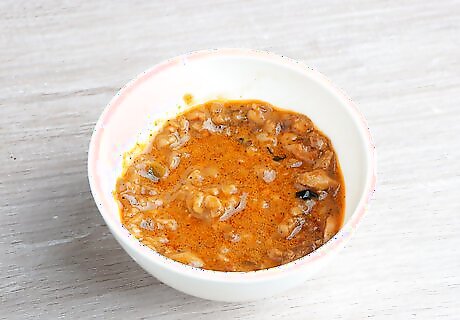
Use berbere to spice up food. Berbere is the chief spice blend in Ethiopian cuisine, recognizable by its brick-red coloring. It is made with chili peppers and spices like cinnamon and ginger, so expect it to taste hot. Many foods are cooked with berbere, but you may also see it as a powder or paste on plates. A spicier version of berbere is called mitmita. Mitmita is served with hotter dishes such as kitfo and dulet, so read menus carefully before ordering. Berbere powder can vary in composition from place to place. Some blends may be less spicy than others. In addition, any food can be made without the spice, so even if you don’t like heat, there is something for everyone.
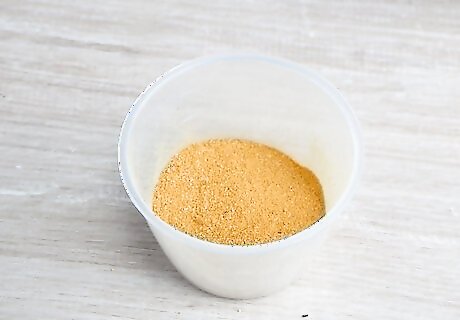
Eat wat as a spicy stew with injera. Wat or wot is perhaps the best-known Ethiopian dish. Wat is often made by combining onions, meat, and berbere. Consider it to be a very red, spicy curry. To eat it, you dip a piece of injera in the sauce and use it to pick up some of the meat. Doro wat, Ethiopia’s national dish, is like a chicken chili. Siga wat is a beef version of the dish, but you may also see other types of meat used. The most common vegetarian option is shiro wat, a slow-cooked chickpea stew. Also look for misir wat, which is made with red lentils.
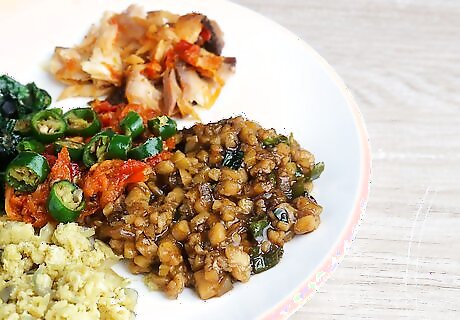
Choose kitfo if you don’t mind eating raw meat. Kitfo can be considered as Ethiopia’s version of tartare. It is made by mixing raw, minced beef with spiced clarified butter and mitmita, so expect it to be spicy. The dish is often served with a special type of flatbread called kocho. Kitfo may be served with cooked greens called Gomen and a mild cottage cheese called ayibe. ”Leb leb” means the meat is warmed but not cooked. Ask for your kitfo “betam leb leb” if you want the meat cooked. Gored gored is an almost identical dish where the meat is cut into cubes instead of minced.
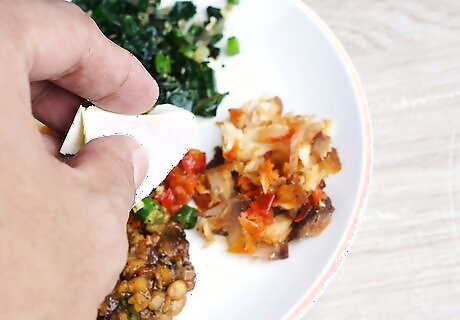
Order tibs for sauteéd meat similar to fajitas. Tibs is made by cooking meat or vegetables briefly in a pan coated in fat. The most common version uses beef and may be mixed with cabbage, carrots, potatoes, or other vegetables. In traditional Ethiopian meals, tibs is often a small side dish to be eaten with injera. Tibs is very customizable. You may see vegetarian versions or versions with lamb meat. The dish can be very spicy depending on how much berbere is used. If it looks red, it will probably be hot. Tibs can also taste very mild if you request it to be made that way.
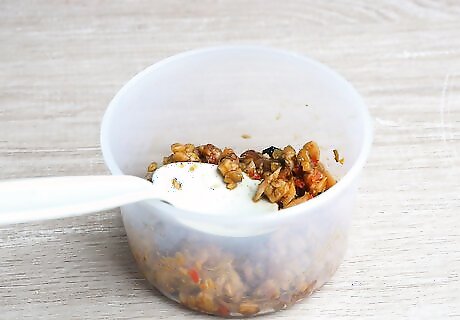
Have fir-fir or fit-fit for a common breakfast food. Fit-fit is made from yesterday’s shredded injera, usually mixed with berbere and a spicy clarified butter called niter kibbeh. The dish tends to taste spicy and tangy. It is one of the rare Ethiopian dishes traditionally eaten with a spoon, although you can always eat it with more injera. Some variations on the dish include scrambled eggs, tomatoes, and onions. Ful is a similar dish often made with eggs and fava beans.




















Comments
0 comment